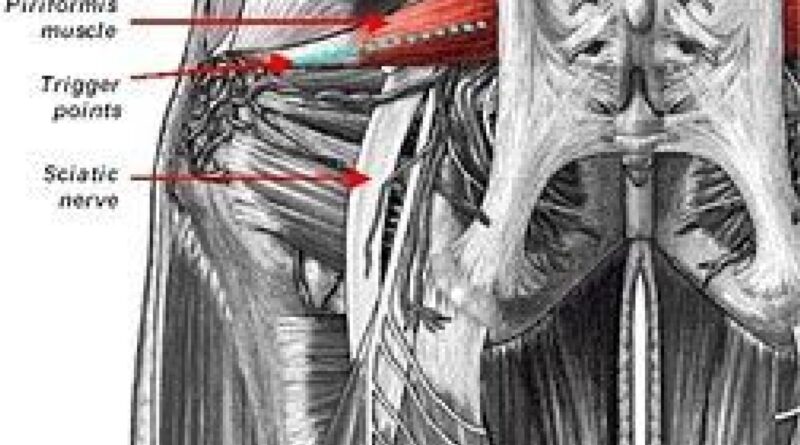Understanding Piriformis Syndrome: Causes, Symptoms, and Treatment
Introduction: Piriformis syndrome is a relatively common yet often misunderstood neuromuscular condition that can lead to significant discomfort and pain in the buttocks and lower back. This article aims to provide a comprehensive overview of relieve pain in buttock, including its causes, symptoms, diagnosis, and treatment options.
I. What is Piriformis Syndrome?
Piriformis syndrome is a condition that arises when the piriformis muscle, a small, pear-shaped muscle located deep within the buttocks, becomes irritated or compressed. The piriformis muscle plays a crucial role in the movement of the hip joint, specifically the rotation of the thigh, and helps to stabilize the pelvis.
The sciatic nerve, which runs from the lower back down through the buttocks and into the legs, passes close to or through the piriformis muscle in some individuals. When the piriformis muscle becomes inflamed or spasms, it can put pressure on the sciatic nerve, leading to pain and discomfort. This condition is known as piriformis syndrome.
II. Causes of Piriformis Syndrome
- Muscle Irritation: The most common cause of piriformis syndrome is the irritation or inflammation of the piriformis muscle due to overuse, strain, or injury. Activities that involve repetitive movements of the hip, such as running or cycling, can contribute to muscle irritation.
- Trauma or Injury: A direct injury to the buttocks, such as a fall or a blow to the area, can lead to piriformis syndrome. In some cases, the trauma may not be immediately noticeable, and symptoms may develop over time.
- Anatomical Variations: Some individuals have anatomical variations, such as the sciatic nerve passing through the piriformis muscle, making them more prone to developing this syndrome.
III. Common Symptoms
The symptoms of piriformis syndrome can vary from person to person, but they typically include:
- Pain in the Buttocks: Pain and tenderness in the buttocks are the hallmark symptoms of this condition. This discomfort can be sharp, burning, or aching and may radiate down the back of the leg.
- Sciatica-like Pain: Many people with piriformis syndrome experience symptoms similar to sciatica. This includes shooting pain, tingling, or numbness that can extend down the leg. Often following the path of the sciatic nerve.
- Reduced Range of Motion: The pain and muscle tightness associated with piriformis syndrome can limit the range of motion in the hip joint, making it challenging to perform activities that require hip rotation.
- Pain While Sitting:. Sitting for prolonged periods can exacerbate the pain associated with piriformis syndrome. As it puts additional pressure on the affected muscle and nerve.
IV. Diagnosis
Diagnosing piriformis syndrome can be challenging as its symptoms overlap with other conditions like herniated discs or lumbar spine issues. A healthcare provider may use the following methods for diagnosis:
- Physical Examination: The healthcare provider may perform a physical examination to evaluate. The patient’s range of motion, pain triggers, and muscle strength.
- Imaging Studies: X-rays, MRI, or CT scans may be ordered to rule out other potential causes of the symptoms and to assess the relieve pain in buttock and its relation to the sciatic nerve.
- Electromyography (EMG): EMG can help determine if the sciatic nerve is being compressed by the piriformis muscle.
V. Treatment Options
The treatment of piriformis syndrome aims to relieve pain, reduce inflammation, and improve the function of the affected muscle. Treatment options may include:
- Rest and Ice: Resting the affected area and applying ice can help reduce inflammation and alleviate pain.
- Physical Therapy: Physical therapy exercises can strengthen the surrounding muscles, improve flexibility, and alleviate muscle spasms.
- Medications: Non-steroidal anti-inflammatory drugs (NSAIDs) and muscle relaxants may be prescribed to manage pain and muscle tension.
- Injections: Corticosteroid injections into the piriformis muscle can provide temporary relief from pain and inflammation.
- Massage and Stretching: Manual therapies and specific stretches can help alleviate muscle tightness and improve mobility.
- Surgery: In rare cases where conservative treatments are ineffective, surgery to release the piriformis muscle may be consider.
Conclusion
Piriformis syndrome can cause significant discomfort and disrupt daily life for those affected. However, with appropriate diagnosis and treatment, most individuals can find relief from their symptoms. If you suspect you have relieve pain in buttock. It’s essential to consult a healthcare provider for a proper evaluation and personalized treatment plan. As with many musculoskeletal conditions, early intervention and a comprehensive approach to care can lead to a successful recovery and improved quality of life.

